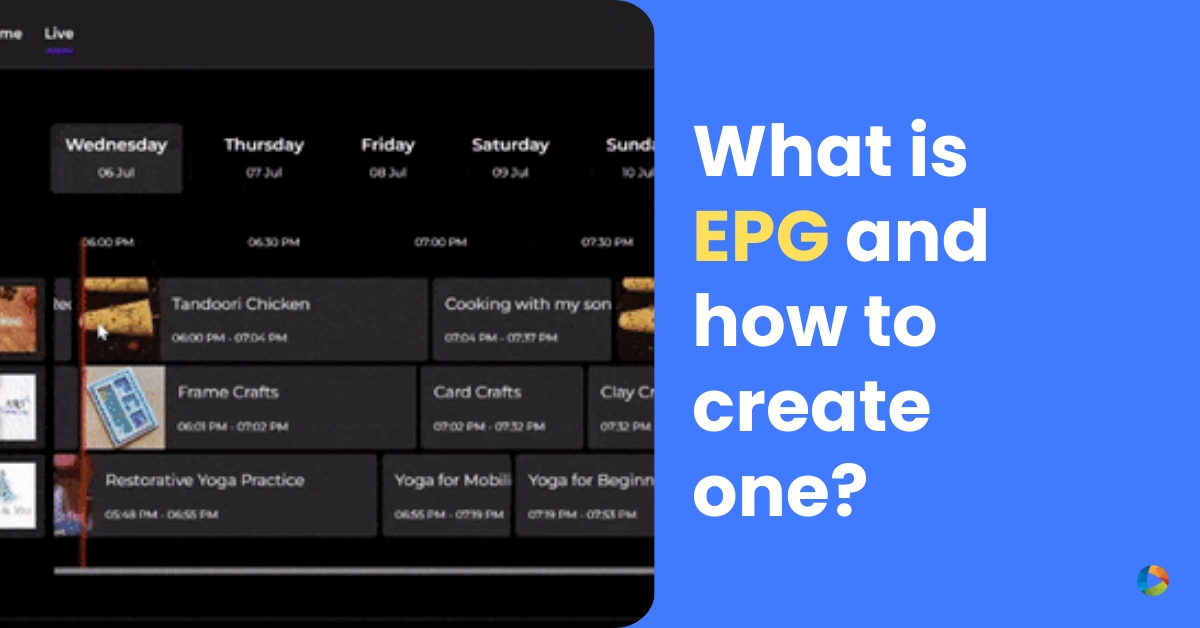Video Resolution: A Beginner’s Guide
Last Updated on May 29, 2025 by Anjana Devi
Video resolution is a commonly used term online. Most people understand it as the quality of the visual display that they see on the screen. However, from a video creator’s perspective, what is a more technical definition of video resolution?
“Video resolution represents the total number of pixels displayed on the screen in each frame.”
For example, if your video resolution is 1080 x 720 pixels, it means that there are 7,77,600 pixels in every single frame of the video.
Table of Contents :
1. What do the terms 480p, 720p, 1080p mean?
2. What are SD and HD resolutions?
3. Difference between Frame rate and Bitrate
4. Which video resolution to choose for your videos
Video resolution is of two types:
- Spatial Resolution: This is represented by the number of pixels in any given frame, based on the width-to-height ratio (or aspect ratio) of the display screen. For example, a spatial resolution of 320m means that each pixel represents an area of 320 X 320 m on the ground. Spatial resolution can be simply understood as the area of your screen (length X breadth) in terms of pixels.
- Temporal Resolution: This is represented by the number of frames shown on the screen per second – more commonly known as the frame rate. When uploading video content on any platform, you will often encounter an acceptable maximum limit of frames per second, e.g. 30 fps, 24fps, 40fps, etc.
What do the terms 480p, 720p, 1080p mean?
These alpha-numeric terms represent the number of pixels displayed vertically or the number of horizontal lines of pixels on the screen.
For example, 720p means that the video has a vertical resolution of 720 pixels.
The horizontal resolution, or the number of pixels in each horizontal line, can be deduced from the aspect ratio of the video. For example, a 720p video with an aspect ratio of 16:9 will have a horizontal resolution of 1280 pixels. A 720p video would have a higher video quality than a 480p as it is almost twice as sharp as the 480p with twice the number of pixels in any frame, and can be viewed free of any disturbances on a larger screen as well.
The other counterpart to understanding video resolutions and how they’re denoted is to differentiate between ‘i’ and ‘p’ that is suffixed in resolutions, like 1080i, 1080p, etc.
The letter ‘i’ stands for ‘interlaced’, while the letter ‘p’ stands for ‘progressive or non-interlaced’.
Interlacing is a technique used to double the frame rate of the video without increasing its bandwidth or file size; used in the encoding of uncompressed videos to improve the final output video resolution. Here, the refresh rate is doubled improving the appearance of any object in motion.
However, with increasing usage of digital video compression in video encoding for all current digital TV standards, interlacing has lost its relevance over time.
What are SD and HD resolutions?
SD is the predecessor of HD video viewing and stands for standard definition video resolution. With an aspect ratio of 4:3, SD is the standard quality resolution that is seen in some videos on the internet and primarily in broadcast television.
The recommended or commonly used video resolution for SD is 640 x 480 pixels. Though you may still find several videos across the internet in the SD format, it is quickly moving towards becoming redundant soon. SD video formats are now replaced by HD, which is the new standard now due to its high-quality and sharper viewing experience, along with affordability.
HD Resolution or High Definition Resolution involves the family of 720p or 1080p resolutions. These are far more common and superior than the SD resolutions or any other 480p video formats.
720p is known as the standard HD or HD ready, to help differentiate it from the higher level 1080p resolutions. The aspect ratio for HDTV, televisions with resolutions in the family of 720p, 1080p, and 1080i, is 16:9, used in widescreen displays. Common HD resolutions include 1280 x 720 pixels and 1920 x 1080 pixels.
720p is popular among most video content found across the internet. The maximum video quality format allowed for Facebook live is 720p. Most television broadcasters prefer it for their standard HD channels.
1080p and 1080i are known as full HD. They have a higher quality than the standard HD videos. 1080i is popularly used by most television broadcasters, while 1080p is the more progressive format in video encoding for platforms like YouTube, Netflix, etc.
Difference between Frame rate and Bitrate
People often confuse the two – frame rate and bitrate of a video. Let’s understand what each term means and the difference between the two
Frame rate refers to the speed or frequency at which the frames appear in a video. Each frame involves a scene from the video in still image form. A combination of all the frames played one after the other, in fast motion, is what leads us to finally see the video in dynamic motion form. The higher the frame rate of a video, the higher is the quality of fast-motion videos.
The frame rate or ‘fps’ varies based on where the content will be viewed. For videos viewed on web portals, TV, and movies, a frame rate of 24 fps is recommended, whereas higher frame rates of 60 fps or 120 fps are usually used in videos that need to be played in slow motion. For videos in slow motion, 60 fps or 120 fps is reduced to 24 fps for a smooth flow of the video at a slower speed as well.
A frame rate of 30 fps is 6 frames lesser than 24 fps per second, which tends to give a smoother visual effect when viewed on live TV or sports streaming. A 60 fps video can be used for a slo-mo effect as it can be reduced to 24 fps, still retaining the video quality. However, for a video recorded at 24 fps speed, there is no scope for a quality output on slowing it down as there are no spare frames left to display the video effectively.
Finally, a higher fps does not at all translate into a higher video quality. A 24 fps and a 60 fps video can have the same quality output on a 1080p display screen.
The frame rate is often confused with the bitrate of a video. Now that you know what frame rate or fps means, let’s see what bitrate stands for.
“Bitrate is the amount of data transferred per second over the internet when a video or audio is encoded.”
It is usually denoted as Mbps or megabytes per second, and Kbps or kilobytes per second. Bitrate plays a huge role in the video display quality, where a higher bitrate means higher video quality, and higher file size as well. A video encoded at a bitrate of 4000 kbps or 4mbps will have a higher quality video output as compared to a 2000 kbps or 2 kbps bitrate. Consequently, the file size of the former will be higher too.
Which video resolution to choose for your videos
Your videos can be encoded in any resolution that you choose. But it’s advisable to encode them in commonly-used resolutions. Here are the most common resolutions:
- 240p
- 360p
- 480p
- 720p
- 1080p
- 2k
- 4k
All the resolutions have their standard video and audio bitrates. For example, for 720p, the standard video bitrate is 2048 and the standard audio bitrate is 128. The size of the encoded file changes when you change the bitrates and/ or the resolution.
There are 3 aspects you need to consider for deciding the resolutions for your encoded videos :
- Video quality
- Buffering time
- Bandwidth cost
All these 3 aspects increase as you increase the resolution.
You don’t want the video quality to be low as it will affect the user experience. You don’t want the video to take a long time to load. At the same time, you might want to keep an eye on the bandwidth cost.
To optimize all the 3 parameters, it’s best to encode your videos in multiple formats and use different formats for different users. Let’s go through the different resolutions available a bit more in detail and their usage.
- 240p
Suited for users whose internet speed is too slow. We don’t recommend this format as the video quality is not good, even on smaller devices. - 360p
Suited for mobile devices for users whose internet is decent but not too fast. The video quality is better than what you will get in 240p. We don’t recommend 360p on laptops and Smart TVs as the quality will suffer. Use 360p when you want to save bandwidth costs. - 480p
We suggest 480p for mobile devices if most of your users have a good internet connection. - 720p
This is the beginning level of HD resolution, known as the standard HD and HD ready. 720p is best suited for laptops and PCs with a decent internet connection. - 1080p
This is probably the most commonly used resolution in smartphones nowadays. 1080p is also known as Full HD and represents a higher quality and sharpness than the standard HD. It is best suited for laptops, PCs, and Smart TVs with a good internet connection. - 2K
Quad HD or QHD or 2K started picking up in the year 2015 with high-quality data streaming. It gets the name Quad HD due to the fact that it comprises 4 times the number of pixels as that in standard HD. Though the display quality is superior to its predecessor, QHD did not get too popular, especially among smartphones because the difference in display quality and sharpness is not much, but the bandwidth required is far more than the 1080p. - 4K
This is probably the best available quality in video display and sharpness today with its widespread use across various streaming platforms. With just a minor difference in the vertical resolution, 4K is often used synonymously with Ultra HD. The video quality is the best but most users don’t have enough internet speed to stream videos in these resolutions. 4K resolutions are mostly used in cinemas and professional production, whereas Ultra HD finds its application in consumer displays and broadcast television. One of the reasons for this is also because of the uncommon aspect ratio or proportion of 4K resolution, which usually tends to distort the images.
These resolutions are sometimes also called Quad Full HD resolutions because the number of pixels used in it is more than 4 times that of Full HD. The Sony Xperia XZ Premium is the first (of many in the future) smartphones to have adopted a 4K resolution display, with currently the world’s highest PPI, or pixels per inch, the density of 806 pixels.
Conclusion
In conclusion, the higher the resolution, the higher the sharpness, and picture quality. This is because there are more pixels in any given frame, carrying more minute audio and video information. More pixels carry finer details of the picture and are clustered together to give a more refined output on the screen. We recommend that the resolutions belonging to the 360p, 480p, and 720p families are ideal for quality streaming on mobile phones and tablets. Whereas, the resolutions of 720p and higher, including 1080p, 2K, and 4K, are better used in computers and smart TVs.
What are your thoughts on this article? reach out to us at info@ventunotech.com if you would like to discuss!
Looking to launch your streaming app?







